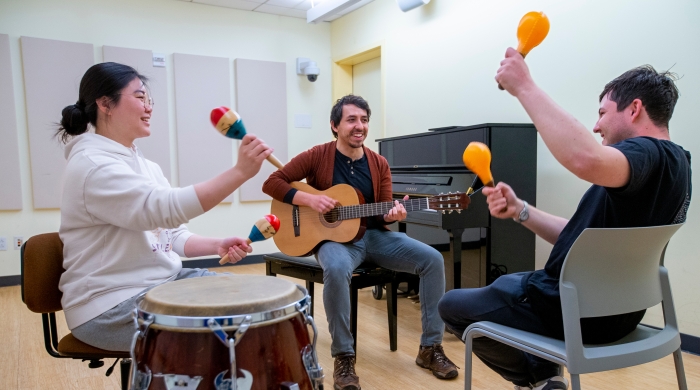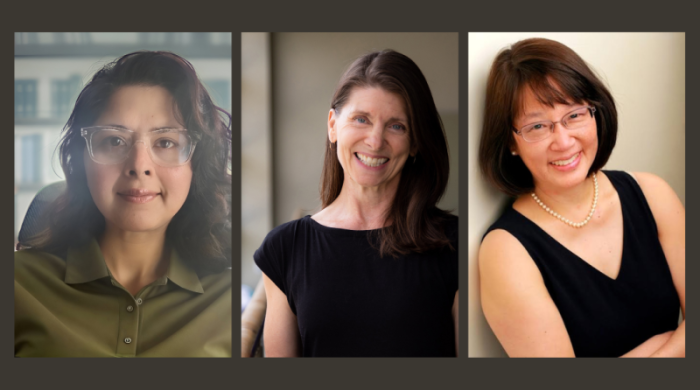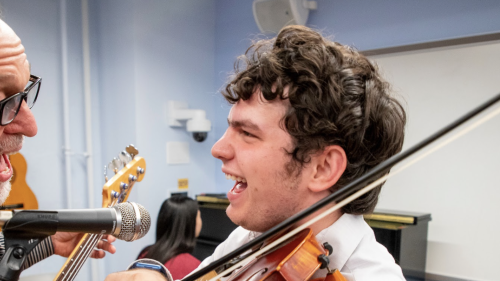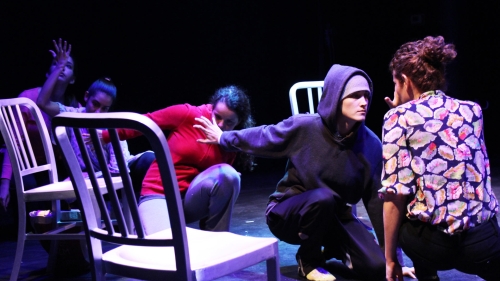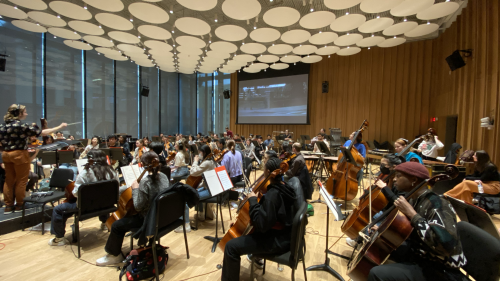As part of the UN’s Healing Arts Week, NYU Steinhardt hosted a symposium exploring the ways music, art, theater, and dance can improve health and well-being. Director of Music Therapy Ken Aigen explains music's healing power.
Even before the pandemic forced Americans to forgo large gatherings and communal events, our culture was experiencing an increase in loneliness, according to the US Surgeon General. Calling it an epidemic, Dr. Vivek H. Murthy issued a report urging Americans to cultivate a culture of connection to improve societal health and reduce isolation, anxiety, and depression.
Music can help.
Thanks to advocates as varied as opera singer Renee Fleming and Grateful Dead drummer Mickey Hart, and institutions such as the Kennedy Center and the United Nations, more attention, research, and funding is going into examining the ways music, art, and other creative endeavors can contribute to a healthier America. NYU Steinhardt spotlit this work on September 18 when it hosted The Art and Science of Social Connection, a day-long symposium presented as part of the United Nations General Assembly Healing Arts Week, produced by the Jameel Arts & Health Lab in collaboration with the World Health Organization (WHO).
Steinhardt Professor Kenneth Aigen participated in an afternoon panel about the ways music can heal trauma and bridge divides. A graduate of the Steinhardt music therapy program, Aigen has taught at NYU since 2013 and he has been the director of the program for seven years. He is a professional musician (he plays guitar, drums, and piano) as well as a therapist, and he oversees the Angel Band Project, a partnership that provides group therapy for victims of sexual and intimate partner violence. As a teacher and clinician, he has watched the field gain visibility and acceptance as a tool for healing.
NYU News sat down with Aigen to talk about the power of music to heal, how music therapy works, and the importance of the recent attention from nationally recognized artists and medical professionals.
Interview with Ken Aigen
How does music therapy work?
The kind of music therapy we practice and teach at NYU is not music for people, it’s music with people. Whether I'm working with an adult victim of trauma, a schizophrenic adult, a stroke victim, or an autistic child, it doesn’t matter. The principles are the same. Using drums, piano, cymbals, and gongs, we play along with the client and the therapist creates a musical context around what the client does. It’s the emotion of music. For a nonverbal autistic child, the focus might be establishing communication and relationship. For someone else, it could be a way to deal with a challenging past experience. Music can convey emotions in a way that words just do not. But the important thing is it’s not just the release of emotions, but that the release becomes part of a creative process. It’s using the energy in those difficult emotions to create something, whether that’s a snippet of music, a song, or a sense of calm. This is essential to the process of empowering clients.
What is required to be a good music therapist?
Music therapists have to have a minimum competence on guitar, piano, voice, and percussion. You have to have a good repertoire and be able to improvise. And it’s essential to be able to use music as a tool of connection, reaching out to the client, rather than just as a form of performance. Some music therapists work in hospitals and they might go room to room, and ask “Would you like some music?” It might help someone achieve some peace, or reflection, and it might open up feelings that they need to talk through. So in the NYU perspective, therapists have to acquire the sensitivities and skills to determine if a pure music experience is what’s called for in a given situation or if a more psychotherapeutic approach is warranted. Our therapists learn how to make this distinction in their clinical work.
Does being a working musician help or hinder a therapist?
You have to be a very good and sensitive musician to be a music therapist, but you sort of have to unlearn a little bit about what you've been taught. It’s not about bringing out what’s inside you. It’s about using music as a tool to reach inside another person.
Can you describe NYU’s partnership with the Angel Band Project?
For six years we have collaborated with this St. Louis-based nonprofit whose mission is to provide music therapy to victims of intimate partner and sexual violence. We provide group therapy to clients from different agencies in New York City, typically three eight-week programs per year. In 2018, we identified some clients who were provided individual therapy with the goal of composing a song that encapsulated their journey of healing. The songs were performed publicly and we produced a CD, Songs of Survival.
In addition to classwork, your graduate students are required to complete clinical training. Where does this happen?
Students work with city agencies to gain clinical experience. We have a cohort of 17 master’s students every year and they work in clinical sites all over the New York metro area in schools, clinics, and community centers. It might be Rikers Island or Memorial Sloan Kettering or Bellevue.
How can music, and music therapy, strengthen social ties? If we are in an "isolation epidemic" as the surgeon general has said, what can music do to combat it?
Music brings people together in unique ways that establish feelings of togetherness. People create music out of our need to feel a sense of community that stems from our common humanity. An aspect of music therapy training is to learn how to use music in this way.
What impact does the recent research (the Sound Health project that Renee Fleming advocates, for example) have on the public's acceptance of the value of music therapy?
The type of research that you are referring to can have an impact on the decision makers in our healthcare and educational worlds who determine what type of services are brought to the individuals in their care. When individuals in the public hear about music therapy, they are often drawn to it out of an intuitive sense of how music enriches human life. However, the research can have a strong impact on the medical directors and insurance company administrators who determine things such as whether to hire a music therapist or a recreation therapist, or whether or not to provide insurance reimbursement for music therapy services.
Of course, of great help is when highly visible individuals discuss music therapy from their first-hand experience. An excellent example is that of Gabby Giffords, the former US Congresswoman who was the victim of a gunshot wound that resulted in her having a severe speech impairment. Music therapy has helped in her recovery and she has been very public about its role in her rehabilitation.
Press Contact
(212) 998-6829
Related Articles
Steinhardt To Host Symposium on the Art and Science of Social Connection
The symposium will be held in collaboration with the Jameel Arts & Health Lab on September 18, 2024.
Clinical Musicianship for Good
For students in NYU Steinhardt’s Music Therapy program, music is more than just an artistic pastime, but a powerful tool in the service of human wellbeing.
Healing, Bridging, Thriving: A Reflection from the Arts and Health Caucus
Dr. Nisha Sajnani and her co-conveners share their reflections from "Healing, Bridging, Thriving: A Summit on Arts and Culture," hosted by the White House Domestic Policy Council and National Endowment for the Arts.

